
Knik River is a census-designated place (CDP) in Matanuska-Susitna Borough in the U.S. state of Alaska. Located 15 miles southeast from Palmer along the Knik River, it is part of the Anchorage, Alaska Metropolitan Statistical Area. The population was 792 at the 2020 census, up from 744 in 2010.

Palmer is a city in and the borough seat of the Matanuska-Susitna Borough, Alaska, United States, located 42 miles (68 km) northeast of Anchorage on the Glenn Highway in the Matanuska Valley. It is the ninth-largest city in Alaska, and forms part of the Anchorage Metropolitan Statistical Area. As of the 2020 census, the population of the city is 5,888, down from 5,937 in 2010.
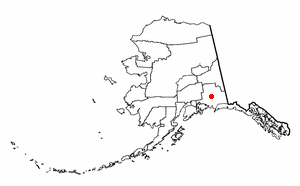
Glennallen is a census-designated place (CDP) in the Copper River Census Area in the Unorganized Borough of the U.S. state of Alaska. As of the 2020 census, the population of the CDP was 439, down from 483 in 2010. It is the most populated community in the census area.
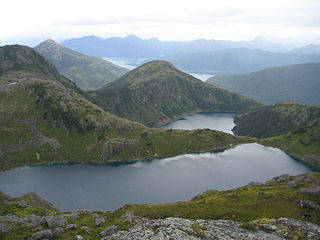
The Chugach Mountains of southern Alaska are the northernmost of the several mountain ranges that make up the Pacific Coast Ranges of the western edge of North America. The range is about 250 miles (402 km) long and 60 miles (97 km) wide, and extends from the Knik and Turnagain Arms of the Cook Inlet on the west to Bering Glacier, Tana Glacier, and the Tana River on the east. It is bounded on the north by the Matanuska, Copper, and Chitina rivers. The highest point of the Chugach Mountains is Mount Marcus Baker, at 13,094 feet (3,991 m), but with an average elevation of 4,006 feet (1,221 m), most of its summits are not especially high. Even so, its position along the Gulf of Alaska ensures more snowfall in the Chugach than anywhere else in the world, an annual average of over 1500 cm (800 in).
The Glenn Highway is a highway in the U.S. state of Alaska, extending 179 miles (288 km) from Anchorage near Merrill Field to Glennallen on the Richardson Highway. The Tok Cut-Off is often considered part of the Glenn Highway, for a total length of 328 miles (528 km).

The Anchorage School District (ASD) manages all public schools within the Municipality of Anchorage in the U.S. state of Alaska. It is the 107th largest school district in the United States, serving over 45,000 students in more than 90 schools.

Chugiak is an unincorporated community in the Municipality of Anchorage in the U.S. state of Alaska, situated approximately 20 miles (32 km) northeast of downtown Anchorage.

Chugach State Park covers 495,204 acres covering a hilly region immediately east of Anchorage, in south-central Alaska.
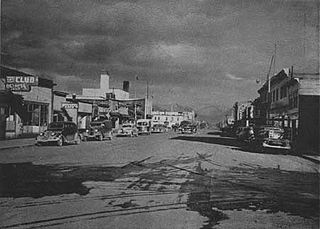
After congress approved the completion of the Alaska Railroad from Seward to Fairbanks in 1914, it was decided that a new town should be built as a port and rail hub along the route. The decision was made to develop a site near Ship Creek on Cook Inlet. Survey parties visited the area in 1914 and researched possible routes for the rails and options for siting the new town. Anchorage was originally settled as a tent city near the mouth of Ship Creek in 1915, and a planned townsite was platted alongside the bluff to the south. Anchorage was mostly a company town for the Alaska Railroad for its first several decades of existence.

Eagle River High School (ERHS) is a public high school in Eagle River, a suburb of the city of Anchorage in the U.S. state of Alaska. Opened in 2005, it serves students living in Eagle River and on Joint Base Elmendorf-Richardson. Enrollment in the 2016-17 year is 894. The current principal is Timothy Helvey.

Mat-Su Regional Medical Center is a 125-bed general hospital in the U.S. state of Alaska. The hospital is owned by Community Health Systems (CHS). Located in the Gateway census-designated place, between Palmer and Wasilla, it is the principal hospital for the Matanuska-Susitna Borough. Owing to its location a short distance from the interchange of the Glenn and Parks Highways, Mat-Su Regional serves as a principal hospital for many of the Glenn Highway communities in northern Anchorage, such as Chugiak, Eagle River, Eklutna and Peters Creek.

Ship Creek (Dena'ina: Dgheyaytnu) is an Alaskan river that flows from the Chugach Mountains into Cook Inlet. The Port of Anchorage at the mouth of Ship Creek gave its name to the city of Anchorage that grew up nearby.

The Municipality of Anchorage is the largest city in the U.S. state of Alaska by population. With a population of 291,247 at the 2020 census, it contains nearly 40 percent of the state's population, and has more people than all of Northern Canada and Greenland combined. The Anchorage metropolitan area, which includes Anchorage and the neighboring Matanuska-Susitna Borough, had a population of 398,328 in 2020, accounting for more than half the state's population. At 1,706 sq mi (4,420 km2) of land area, the city is the fourth-largest by area in the United States and larger than the smallest state, Rhode Island, which has 1,212 sq mi (3,140 km2).

Government Hill is a neighborhood in the northwest part of Anchorage, Alaska, sitting in between Anchorage's downtown area and the western reaches of Joint Base Elmendorf-Richardson, specifically the portion formerly known as Elmendorf Air Force Base. The neighborhood is named for the "hill" it sits on of about 115 feet (35 m) bearing the same name, which is actually a bluff which rises alongside the northern banks of Ship Creek. The origins of the name date to 1915, when a federal land reserve was created in the area for the Alaska Engineering Commission, then heavily involved in constructing the Alaska Railroad nearby.

Randell Ernest "Randy" Phillips is a retired politician from the U.S. state of Alaska. Phillips served for twenty-six years as a Republican member of the Alaska House of Representatives and the Alaska Senate, from 1977 to 2003.

The Eagle River is a stream, 40 miles (64 km) long, in Anchorage, Alaska. Heading at Eagle Glacier in Chugach State Park, it flows northwest into Eagle Bay on the Knik Arm of Cook Inlet, 9 miles (14 km) northeast of downtown Anchorage.

Tikahtnu Commons is a 900,000 square foot power center located on a 95-acre parcel in Anchorage, Alaska, United States. It is owned by Cook Inlet Region, Inc., an Alaska Native corporation and Browman Development Company, a California corporation. The shopping center consists of several large anchor stores, dozens of smaller restaurants, shops and services, and a 16-screen Regal Cinemas theater. Tikahtnu is the word for Cook Inlet in the Dena'ina language. Tikahtnu Commons is home to many firsts for Alaska, including the state's first Kohl's, PetSmart and IMAX theater. Tikahtnu Commons is the largest single-owner shopping center in the state and is even large by national comparison. The International Council of Shopping Centers states that power centers in the United States typically range from 250,000 to 600,000 square feet with an average of 420,160 square feet (39,034 m2). Construction of the center began in 2007 and by the summer of 2015, it had been developed to roughly 98% capacity. Anchors include Lowes, Old Navy, Petsmart, Kohls, Burlington, Target, Best Buy, Regal Cinemas, and Costco.
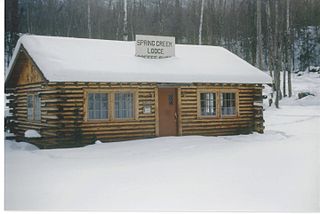
The Spring Creek Lodge is a historic former restaurant at 18389 Old Glenn Highway in the Chugiak area of Anchorage, Alaska. Vernon and Alma Haik built the Spring Creek Lodge in 1949. It served as an essential eatery and community center in southcentral Alaska from 1949 to 1974. The lodge was famous for its homemade bread and banana cream pies, and it was the place to go for a hearty Sunday dinner. For 25 years, the lodge served homesteaders, hunters from the Matanuska Valley, and military personnel from the Elmendorf Air Force Base and Fort Richardson in Anchorage. The lodge stands at Mile 20 on the two-lane Palmer Highway halfway between Palmer and Anchorage. It also served as the first community center for the early settlers of Chugiak. On September 9, 2001, the Spring Creek Lodge was inducted to the National Register of Historic Places "in recognition of its contributions to the cultural heritage of Alaska." The restaurant was a local landmark until its location was bypassed by the new Glenn Highway in 1969, after which it closed.
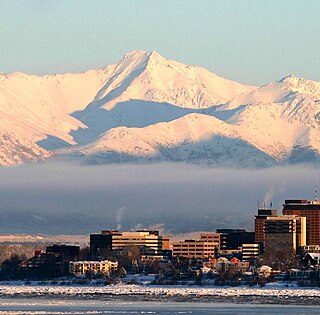
Vista Peak is a 5,019-foot (1,530 m) mountain summit in the U.S. state of Alaska.






















